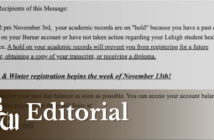Walking into a Lehigh classroom can feel like immersing oneself in Times Square. Everywhere, blinking lights grab your attention, announcing company names and slogans. Every building is claimed.
Similarly, most of the students in any given classroom wear the name of the Lehigh organization they identify with most on their shirts. Gaze across the rows, and an array of musical groups, Greek letters, sports teams and other affiliations stare right back. We are all branded.
These organizations are supposed to make students feel more connected, but somehow they also seem to be simultaneously dividing our student body.
Gone are the glorious days of the first week at Lehigh, where new students wander around campus giddily with their Lehigh T-shirts fresh from orientation. Each year, those shirts quickly fall to the wayside as they’re replaced with ones representing specific student groups.
Unfortunately, those Lehigh shirts aren’t the only things being forgotten during the shift from orientation to daily Lehigh life.
The excitement of meeting new people, seeing a potential friend in everyone and the bravery to stay open to new experiences disappears after the initial period of novelty wears off. Somewhere in that transition, we find a group of friends and decide they are enough.
When you’re new to a community, you want to feel like you belong. Finding a group that you feel happy with is a powerful source of comfort. Being happy with one group doesn’t require removing yourself entirely from any outside social interactions, though. You’re not married to your friends; you can still “see other people.”
Why give up that accepting, orientation mindset after discovering one group? Can one group truly capture all your areas of interest, all your different personality traits?
Lehigh has 4,904 undergraduate students and 2,165 graduate students who study subjects from pharmaceutical chemistry to music composition. Students from all over the U.S. and the world bring their unique perspectives based on a mixture of personal, cultural, ethnic, socioeconomic, and gender traits. Even within one student there are so many facets to explore.
Think of all the stories, experiences, conversations, ideas and laughs you’re missing out on if you limit yourself to even 100 Lehigh friends, which would seem like a pretty large number to most.
The Lehigh community is constantly in flux, acquiring transfer students, graduate students and first-year students throughout the year, so why do social interactions within the student body become so static and fixed?
One major indication of the lack of connection amongst students is the “Lehigh Lookaway,” a term describing the way in which Lehigh students will purposefully avoid acknowledging each other while walking around campus. What other university has a campus-wide term for how students ignore one another?
College is supposed to be an eye-opening experience where all types of great minds meet, but instead we desperately focus on the sidewalk in fear of risking awkward eye contact.
Maybe one of the reasons why we lose that sense of open-mindedness is because during orientation and the first few weeks of school at Lehigh, all the first-year students are expected to be nervous. They’re expected to be vulnerable and a little homesick, and everyone knows they’re just looking for friends and welcoming faces.
Once that phase is over, we no longer have an excuse. We’re expected to have already found our place and overcome our initial confusion over our identity and how we fit in at Lehigh. The walls dividing us build up because we don’t want to experience that disorienting feeling of first-year vulnerability any longer than necessary.
But we should embrace our vulnerability because it’s what makes our interactions so meaningful. That delicate first conversation, searching for the right words, could start a lifetime friendship or end in 30 seconds flat. It’s that risk, though, that keeps us searching and finding and expanding, so we don’t settle for the familiar and confine ourselves to a perpetual bubble.
“Vulnerability is the only authentic state. Being vulnerable means being open, for wounding, but also for pleasure. Being open to the wounds of life means also being open to the bounty and beauty. Don’t mask or deny your vulnerability: It is your greatest asset. Be vulnerable: Quake and shake in your boots with it. The new goodness that is coming to you, in the form of people, situations, and things can only come to you when you are vulnerable, i.e. open,” says Stephen Russell in his book, “Barefoot Doctor’s Guide to the Tao: A Spiritual Handbook for the Urban Warrior.”
Maybe we have found our places at Lehigh, maybe we haven’t. Is either really a reason to cut each other off from our peers? We have this horrible habit of viewing our peers like the letters on their shirts and assuming that their identity ends there. We shouldn’t create these defining factors that fall flat when we hold them up to the multi-faceted students they represent. We shouldn’t sell each other short by allowing stereotypes and fear of vulnerability separate us.
Talking before class and actually smiling when we cross paths might require a little orientation-style vulnerability, but what’s the harm in that? Putting ourselves on the line and making new friends in addition to the ones we already have is worth it. We all survived orientation and felt more connected to the Lehigh community because of it.





Comment policy
Comments posted to The Brown and White website are reviewed by a moderator before being approved. Incendiary speech or harassing language, including comments targeted at individuals, may be deemed unacceptable and not published. Spam and other soliciting will also be declined.
The Brown and White also reserves the right to not publish entirely anonymous comments.